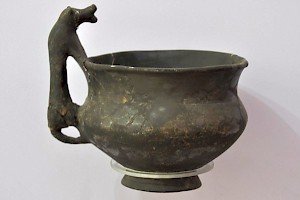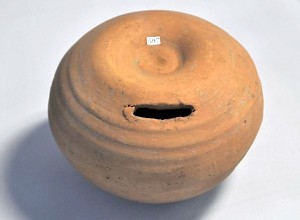Angela
Elite member
- Messages
- 21,823
- Reaction score
- 12,328
- Points
- 113
- Ethnic group
- Italian
Some general information on Viminacium:
[FONT="]The ancient city of Viminacium is situated at the place where the river Mlava, the ancient Margus, empties itself into the Danube. This means that here, three important roads came together. In the first place, there's the road upstream along the Danube to Pannonia or (along the river Sava) to the Adriatic Sea. In the second place, there's the road downstream to Moesia and the Black Sea. And finally, there's the road along the Mlava to Naissus, Thessaloniki, and the Aegean. And of course you could also go to the north, to the Great Hungarian Plain. Three rivers and a plain: this was a very fertile area.[/FONT][FONT="]In the Iron Age, this was the eastern part of the land of the Scordisci, a tribe that belonged to the La Tène civilization and may be called "Celtic", although there wereThracian and Illyrian influences. A necropolis from the Iron Age has been identified at Pećine, close to Viminacium.[/FONT]
 Celtic cup from Viminacium[FONT="]The Romans became interested in the region during the Illyrian Wars. It has been argued that the Fourth Legion Scythica stayed in Viminacium (or the neighborhood) during the first half of the reign of the emperor Augustus; the area appears to have been pacified in 12/11. Another unit that may have stayed here for a short while, is the Fourth Legion Flavia Felix, which took part in Domitian's war against the Dacians after 86. However, it would soon find its permanent base in Singidunum (Belgrade), and Viminacium was to be the permanent base of the Seventh Legion Claudia.
Celtic cup from Viminacium[FONT="]The Romans became interested in the region during the Illyrian Wars. It has been argued that the Fourth Legion Scythica stayed in Viminacium (or the neighborhood) during the first half of the reign of the emperor Augustus; the area appears to have been pacified in 12/11. Another unit that may have stayed here for a short while, is the Fourth Legion Flavia Felix, which took part in Domitian's war against the Dacians after 86. However, it would soon find its permanent base in Singidunum (Belgrade), and Viminacium was to be the permanent base of the Seventh Legion Claudia.(It has sometimes been stated that "Fourth" Legions were raised in Rome and commanded originally by consuls, and that indeed seems to be the case for the Scythica and perhaps for the Flavia Felix. The Seventh Claudia was raised for the campaigns in Cisalpine Gaul by Julius Caesar, then disbanded and settled in Capua, and then re-established and sent to Moesia. Of course, there were also auxiliary troops, but I have no definitive information about them except to say that often troops were sent from the east to the west and vice versa. Then you have administrators merchants, attendants and on and on. Given the city was utterly destroyed, as was Rome, I have my doubts any of these people would necessarily have impacted future generations in the area. This is the kind of mistake population geneticists make all the time.)
[/FONT][FONT="]During the Dacian Wars of the emperor Trajan, in 101-102 and in 105-106, Viminacium appears to have been the headquarters of the Roman army. The famous bridge of Trajan, which Apollodorus of Damascus built across the Danube, was only some 115 kilometers to the east of the legionary base of VII Claudia.
The city also played a vital role in the civil administration of this part of the Roman Empire. Viminacium was the place where the procurator of Moesia Superior had his office: this man was in charge of the taxes and the imperial domains, and was a very important official.[/FONT][FONT="]Viminacium was probably the place where, in 196, the emperor Septimius Severus proclaimed his son Caracalla Caesar. This may not have been a terribly important event, because it was already clear that Caracalla was the intended successor of Severus, but it is nevertheless significant that happened over here, where three roads came together and the news could be spread all over the Empire very rapidly.[/FONT]
 Money box[FONT="]In 239, the emperor Gordian III gave the city the rank of colonia. Coins were minted here too, and this was the place where, in 285, Diocletian overcame his rival Carinus.note When the provinces were rearranged, Viminacium became the capital of Moesia Prima.[/FONT][FONT="]The mid-third century mausoleum is an interesting archaeological discovery. Situated in an enclosure of about 20x20 meters, this was the final resting place of a wealthy young man; an older woman has been buried in a separate tomb within the same enclosure. It has been assumed that these were the tombs of one of the sons of the emperor Decius (r.249-251), Herennius (died 251), and of Herennia Etruscilla.[/FONT](I'd really like to see the evidence for the latter.)
Money box[FONT="]In 239, the emperor Gordian III gave the city the rank of colonia. Coins were minted here too, and this was the place where, in 285, Diocletian overcame his rival Carinus.note When the provinces were rearranged, Viminacium became the capital of Moesia Prima.[/FONT][FONT="]The mid-third century mausoleum is an interesting archaeological discovery. Situated in an enclosure of about 20x20 meters, this was the final resting place of a wealthy young man; an older woman has been buried in a separate tomb within the same enclosure. It has been assumed that these were the tombs of one of the sons of the emperor Decius (r.249-251), Herennius (died 251), and of Herennia Etruscilla.[/FONT](I'd really like to see the evidence for the latter.)The above comes from a non-academic site, so take with a grain of salt.
https://www.livius.org/articles/place/viminacium/
What is from an academic site is the following:
Next to the legions participating in the two expeditiones Dacicae1the auxiliary troops from theprovinces close to Decebalus' kingdom, Pannonia, Moesia Inferior and particularly Moesia Superior,played also an important role. Given that Moesia Superior was the main attack base against the Daciankingdom, the auxiliary troops from this province played a far more important role than the troops fromthe other two mentioned provinces. In fact Trajan did not bring new units to Moesia Inferior either, untilstarting with year 102, when the auxiliary troops from the latter intervened for the first time at the northof the Danube after Decebalus' and his allies' attack on the province, which would argue in favour of theassumption that Trajan did not intend to open a so-called second front2as he believed that a direct attackthrough Banat region on the centre of the Dacian kingdom could be decisive.
https://www.academia.edu/460373/Par...from_Moesia_ Superior_in_Trajans_Dacian_Wars

